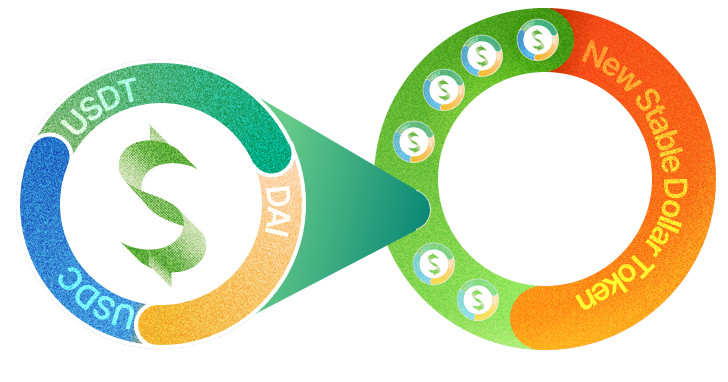Balancer Launches MetaStable Pools To Further Pool Liquidity

Balancer partners with Lido on joint MetaStable Pool incentive program
Balancer is thrilled to announce the launch of MetaStable Pools and our partnership with Lido with joint pool incentives. While Stable Pools are important for tokens with a 1:1 value, MetaStable Pools are great for tokens with highly correlated, but not hard-pegged, prices. Because of this, MetaStable Pools are especially well suited to handle pegged tokens that gradually accumulate fees.
One of the most powerful use cases for MetaStable Pools is “nesting” other pools by holding their Balancer Pool Tokens (BPTs), thereby facilitating cheap swaps between their constituent tokens and those of the nested pool — as though all the component tokens were in a single pool. A MetaStable Pool with StaBAL3-USD (made of DAI, USDC, and USDT) and NewUsdStable tokens could be used to swap between NewUsdStable and any of the nested StaBAL3-USD tokens (DAI, USDC, USDT).
While Stable Pools are well suited for tokens with 1:1 exchange rates, MetaStable Pools work well for tokens that gradually diverge in value. In the above example, StaBAL3-USD is highly correlated with the price of a US dollar, but the pool token grows in value as trade fees accumulate. Similarly, a MetaStable Pool with DAI and cDAI would work well, since the cDAI slowly grows in value as the underlying DAI is lent on Compound.
MetaStable Pools also offer further benefits to traders and liquidity providers. Previously, someone looking to facilitate trades between NewUsdStable, DAI, USDC, and USDT might create a standard Stable Pool with the four tokens. As a MetaStable Pool, however, this pool can piggyback on the deep liquidity of StaBAL3-USD, offering the best prices to traders. This also reduces the fracturing of stablecoin liquidity, which improves prices and increases maximum trade amount. Simultaneously, liquidity providers for StaBAL3-USD do not need to worry about the potential volatility, security, or failure of NewUsdStable since MetaStable Pools prevent the draining of underlying pool tokens.
MetaStable Pools help users of Balancer Protocol list less liquid assets and prevent diluting existing pools.
Balancer Partners with Lido
With the MetaStable Pool launch, liquid staking protocol Lido is launching a pool to facilitate trades between Ether and Staked Ether to offer liquidity for stakers securing the Ethereum Network. We’re excited to increase the number of liquidity pools for the Ethereum staking community and to support growing liquidity conditions for Lido’s stETH token. Furthermore, cooperation with Lido will go a long way in enhancing the productivity of stETH/wstETH.
The pools will be co-incentivised with LDO and BAL rewards to drive further liquidity and offer users with sufficient liquidity rewards to encourage participation.
2,500 BAL per week has been allocated to the pool with an additional 25,000 LIDO per week for the first month. These are live right now, and the first distribution will take place on August 24th via Balancer’s claim portal.
Examples of MetaStable Pools with use cases:
Balancer’s StaBAL USD & NewUsdToken
- Swap NewUsdToken and any of the underlying stablecoins (DAI, USDC, USDT)
ETH & sETH
- Swap ETH and Synthetic Ether.
cDAI & cUSDC
- Swap directly between underlying stablecoins (DAI, USDC)
MetaStable Pools are extremely important for Balancer V2 in that they help to aggregate all of the liquidity to a few pools. Any new stable token can be added to a new pool that uses the BPT of that main stable pool as the other underlying token.
Highly-Correlated vs. Hard-Pegged Tokens
Highly-correlated assets differ from hard-pegged assets in a variety of ways.
Hard-pegged tokens can reliably be exchanged 1-to-1 and the most common are stablecoins. In many cases stablecoins are tied to fiat, but there are other instances as well, such as stablecoins tied to commodities. Tether (USDT), USDCoin (USDC), Perth Mint Gold Token (PMGT) and wDGLD are some examples of stablecoins that are hard-pegged to their underlying assets.
In contrast, tokens like Wrapped BTC (WBTC) and renBTC are ERC20 tokens that are highly-correlated to Bitcoin. Both tokens enable Bitcoin holders to use tokenized Bitcoin in Ethereum-powered decentralized applications like Balancer Protocol and trade on decentralized exchanges.

PR, Balancer, Cryptocurrency, Lido, MetaStableRead More
OhNoCrypto
via https://www.ohnocrypto.com
, @KhareemSudlow

